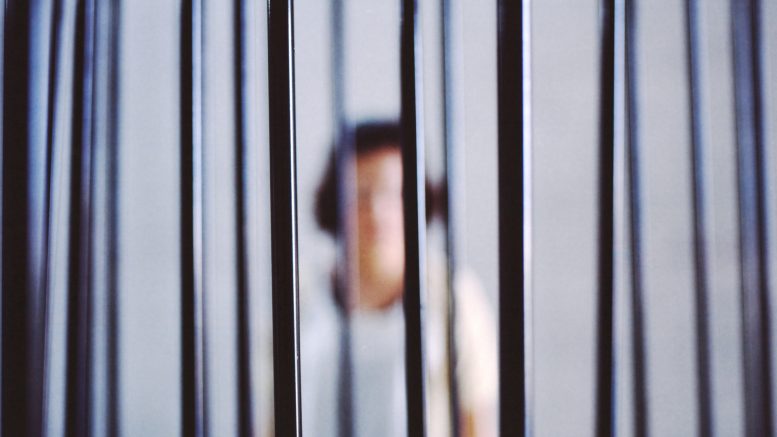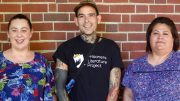Can we learn to look at violence as an aspect of pain?
By George B. Sánchez-Tello, Capital & Main
This story is produced by the award-winning journalism nonprofit Capital & Main and co-published here with permission.
Hurt people hurt people, so the saying goes. In California’s prison and parole system, that’s more than 142,000 women and men who have been hurt. Prisons are designed to punish, not heal. But recent research and work within prisons demonstrates that despite concrete and razor wire, incarcerated men and women are addressing their own trauma.
Last week in Norco, I went to the California Rehabilitation Center and talked with more than 200 incarcerated men throughout the day. I was invited as one of a handful of guests to discuss the ripple effects of violence on individuals, families, neighborhoods and communities. In observance of National Crime Victims’ Rights Week, we guests spoke about how our experiences with crime mark us as victim but also witness. But as I listened closely to how the incarcerated men responded and gave testimony, I realized they were also victim and witness. Such a radical, complex idea — that incarcerated people can be both victims and victimizers.
“Anger is an aspect of pain,” explained Nena Messina, a criminologist who researches crime, mental health and substance use. “Learning the skills of how to not react with violence; hurt people hurt people. It is vital that human beings heal from deep, deep wounds.”
A growing body of evidence supports this concept that incarcerated men and women, when given the support and tools, can acknowledge their trauma, take responsibility for the harm they caused and transform.
The same week I visited Norco, there were more than 95,000 people in prison in California. Including parole and other forms of out-of-prison custody, there are more than 142,000 people under the supervision of the California Department of Corrections and Rehabilitation.
Mental illness is a growing problem inside California’s prisons and jails. In 2018, almost 37,000 people — approximately 29% of incarcerated people — received some form of mental health treatment, according to the California Budget and Policy Center. That’s up by more than 4,000 individuals from five years earlier.
Among the mental health needs of California’s incarcerated men and women are increased screening for ACEs, or Adverse Childhood Experiences — forms of trauma experienced as children that can have lasting impacts into adulthood. The first study of Adverse Childhood Experiences was a collaboration between the Centers for Disease Control and Kaiser Permanente in Southern California in the 1990s. The ACEs survey found more than 60% of adults suffered a traumatic experience as a child, such as abuse, neglect and violence; witnessing drug and alcohol abuse; and losing a parent to separation, divorce or death. Some 17,000 individuals were surveyed about their childhood experiences and adult health trajectory. But one group was missing from the original study: the incarcerated.
“Incarcerated people are an invisible population,” said Messina. A survey of childhood trauma among incarcerated people not only creates a more full portrait of community needs; it also helps contextualize crime and substance use, she explained.
Messina’s work suggests that most incarcerated people have experienced a traumatic event as a child: The incidence among drug-dependent offenders is 77%-90%. Recognition of that trauma may be a starting point for treatment and a potential reduction in rates of recidivism, or the likelihood someone convicted of a crime will offend again.
Beginning with her work as a doctoral student, Stephanie Covington was working among women in Southern California with addictive disorders. Some were in treatment, some were in mutual help groups such as 12 step programs, but she kept finding a consistent theme of early and childhood trauma.
“A lot of women who’ve been abused think this is normal and happens to everyone,” Covington explained.
This led her to work with justice-impacted women, who have the highest rates of addictive disorders, she said. That’s also where she began to learn the connection between experiencing abuse and harming others.
Covington provides trauma-informed care programs in California prisons, including isolated supermax Pelican Bay. She teaches incarcerated people about trauma: how it can lead to aggression, depression and anxiety, and how to cope. Peer facilitation — incarcerated people listening and learning from other justice-impacted individuals — is ideal, she says. “Just to learn about trauma made change,” explained Messina.
Creating a trusting and nurturing environment in a setting meant to punish individuals has not been easy. The only way to run her program with men in the security housing unit was for them to be essentially standing in cages. Those who completed the program wore shackles and belly chains constraining their wrists at graduation.
The California Department of Corrections and Rehabilitation commissioned multiple studies that demonstrated the cost-effectiveness of implementing Covington’s method. More than half the 511 incarcerated men who participated were in prison for murder, attempted murder or assault. Of those, 75% had more than two adverse childhood experiences — 40% admitted more than five childhood experiences of trauma. More than half of participating men admitted to having suffered severe physical abuse as a child and would go on as adults to hurt others.
Researchers found improvements in anxiety, depression, PTSD symptoms and aggression. The same changes were found among incarcerated women who worked with Covington. More than half of these women had over four adverse childhood experiences, including verbal abuse, sexual abuse, physical abuse and emotional neglect. Yet they also demonstrated empathy, social connectedness and emotional regulation.
“These things are making a difference for people,” Covington said.
* * *
I arrived at the California Rehabilitation Center in Norco for an event to mark the federally recognized National Crime Victims’ Rights Week, whose existence is an admission of failure: Our system of punitive justice neglects the many who have been harmed.
I was invited, along with other guests, to speak and listen to incarcerated men. One guest spoke about being sexually assaulted as a child and how it impacted his life, relationships and marriage and shaped his concept of manhood. An author and award-winning investigative reporter spoke about surviving assault and rape as a teenager. I shared my observations as a mitigation specialist and crime reporter.
I was assigned to a room with 80 plastic folding chairs in a semicircle. There were no windows, though posters and art brought color to the room. Air purifiers were set next to large fans, creating industrial noise that made it necessary to use a P.A. system.
Rules and group guidelines were posted on the walls: no cross talk; confidence; no hats; no electronics; be sober; participate; respect.
The event was organized by Gilbert Bao, who only a few years before was serving a life sentence in Soledad. Some of the men today knew he used to wear blue, like them. In many ways he is a peer.
Since completing his classes and certification in prison, Bao has become a substance use disorder counselor. At Norco, he teaches the Victim Impact curriculum, which looks closely at various crimes, their impact, the experience of the harmed and how incarcerated people can take responsibility for their actions and change. Bao cannot stray too far from its lesson plans, despite vast wisdom gained while incarcerated. I later asked him about trauma-informed care. He sighed: “There’s very little treatment outside of medication — or overmedication, as I call it.”
As guests and incarcerated men alike spoke, understanding of trauma and its impact began to surface. No one explicitly mentioned the Adverse Childhood Experience survey, but their lives reflect it.
One speaker asked who in the room had experience with Child Protective Services, prodding to see what sort of support they had had as young men and when they were first impacted by the justice system. About one quarter of the room raised their hands. A man near the front, slouched in his chair with his arms crossed over his chest, didn’t bother to stand or use the microphone in responding.
“It’s hard for me to care about people because nobody cared about me,” he barked over the roaring fans.
A wiry man, anxious to speak, grabbed the mic when invited to share.
“I pulled a gun in front of my son. What am I teaching him?” he said. “We gotta stop the cycles of violence.”
A few minutes before the session ended, one man shuffled forward to testify. He briefly shared a story of ordering a friend to kill another person. That friend is serving a life sentence. The speaker recognized the many ways the murder impacted the dead man’s family. Yet he was grateful to contemplate his actions during today’s event and the Victim Impact classes.
“It gives us the ability to reflect on the ripple effect of violence,” he said. “I was a victim. I‘ve victimized people. That shit hurts.”
Over the loud force of the fans, air purifiers and men anxious from sitting for so long, I heard a simple phrase throughout the day: “I’m sorry.” Incarcerated men, strangers, apologizing to a woman, the guest who shared her story of surviving rape decades ago. But their words set something off in that speaker, evident by her tears and voiced appreciation for their apologies.
Amidst the concrete and razor wire, maybe the men found something in Norco. Whatever the intent of bearing witness to her story, the men vocalized accountability and the desire to heal.
Covington has seen it. Bao has seen it. Messina has seen it. And now I saw it.
That shit hurts.






Be the first to comment on "Incarcerated men and women are learning to address their own trauma"